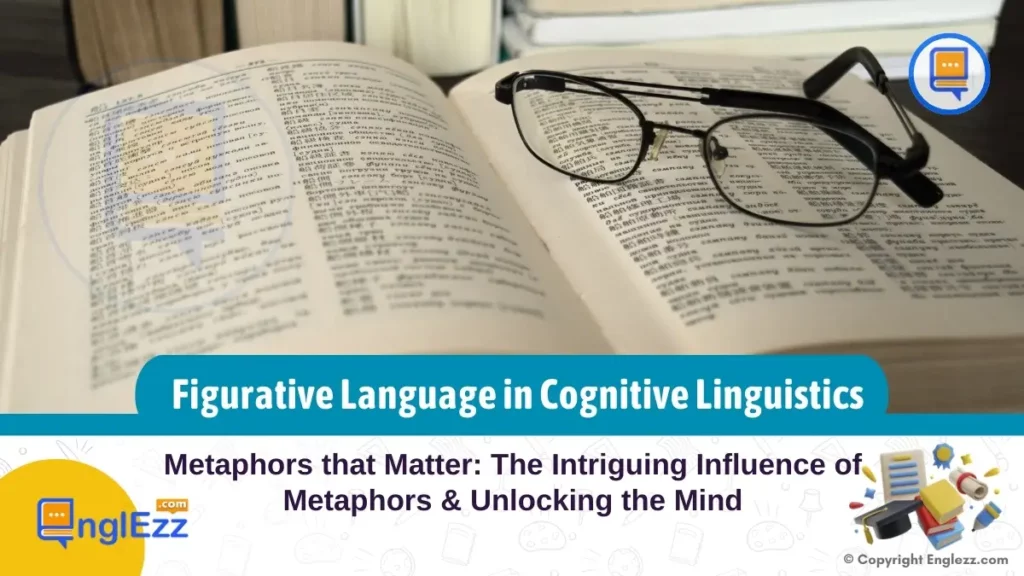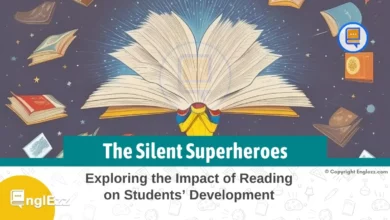In the intricate tapestry of linguistic exploration, metaphors stand as vibrant threads weaving together the fabric of cognitive linguistics. Beyond mere linguistic adornments, metaphors lay bare a profound interconnectedness between language, thought, and perception. They serve as windows into cognitive realms where abstract ideas take tangible form, guiding us through landscapes of understanding previously veiled in complexity.Unleash the power of figurative language in cognitive linguistics! Explore how metaphors shape our understanding in this engaging study.
Metaphors not only adorn our speech but also structure our very cognition, sculpting the lenses through which we view the world.
Metaphors that Matter: The Power of Figurative Language in Cognitive Linguistics
As we venture into the realm where language meets cognition, the role of metaphors emerges as a pivotal force reshaping how we interact with words and ideas. Delving deeper than surface-level expressions, metaphors act as bridges connecting seemingly disparate concepts, offering pathways for our minds to traverse intricate intellectual terrain.

Through metaphorical language, we transcend the boundaries of literal interpretation to navigate the nuanced nuances that underpin human communication and comprehension. By unraveling these intricate linguistic knots, we unravel new dimensions in understanding how metaphorical expressions wield significant influence on our mental landscapes.
The Basics of Cognitive Linguistics
Cognitive linguistics introduces a fascinating perspective on language by emphasizing the importance of understanding how the mind processes information and constructs meaning. At its core, cognitive linguistics explores the intricate interplay between language, cognition, and human experiences. Unlike traditional linguistics that primarily focuses on formal structures, cognitive linguistics delves into how our mental processes shape the way we use language to communicate complex ideas and express our thoughts effectively.
Metaphors serve as essential building blocks in cognitive linguistics, acting as powerful tools that enable us to grasp abstract concepts through tangible representations. For instance, when we say “time is money,” we are not merely expressing a correlation; we are engaging in a metaphorical understanding that time can be valued similarly to currency. These metaphors provide us with shortcuts to convey deep meanings efficiently and aid in structuring our cognitive processes by linking familiar concepts with more abstract notions.
Furthermore, cognitive linguistics studies reveal that metaphors are not just linguistic decorations but fundamental mechanisms intertwined with how we perceive reality and construct knowledge. By examining the influence of metaphorical expressions on cognition, researchers highlight how these linguistic devices shape our mental frameworks and mold our understanding of various phenomena. Through this lens, it becomes evident that metaphors play a pivotal role in shaping our thought processes and influencing how we interpret the world around us.
Unpacking Metaphors in Language: Enhancing Understanding and Perception Through Figurative Language
Metaphors serve as linguistic bridges that connect abstract ideas with concrete experiences, enriching our cognitive processes by offering familiar analogies to grasp complex concepts. By blending two seemingly unrelated domains, metaphors transform the intangible into something tangible, making abstractions more accessible and vivid to our minds. For instance, in the metaphor “time is money,” time, an elusive concept, is linked with money, a concrete entity we can comprehend. This association allows us to value time as a valuable commodity that can be spent or saved like money. The effortless transfer of meaning from one domain to another showcases how metaphors simplify intricate notions for easier comprehension.
Common metaphors embedded within our everyday language subtly shape our perceptions and cognition without us even realizing it. Consider the metaphor “love is a journey.” In this expression, the experience of love is likened to embarking on a voyage filled with ups and downs, twists and turns. Through this comparison, individuals may approach relationships with a sense of adventure and perseverance, viewing challenges as part of the journey rather than insurmountable obstacles. This interconnectedness between metaphorical language and mental imagery highlights how figurative expressions influence not only how we communicate but also how we interpret the world around us.

The profound connection between metaphorical expressions and mental imagery underscores the power of figurative language in stimulating our imagination and understanding. When we encounter metaphors like “the world is a stage,” our minds automatically conjure up images of actors performing on elaborate sets against various backdrops. These mental images facilitate a deeper comprehension of abstract ideas by grounding them in familiar visual representations. By tapping into sensory experiences through metaphoric language, individuals can grasp intricate concepts more effectively as they draw upon their internal imagery to make sense of metaphorical constructs.
In exploring how metaphors unpack complex ideas within language, it becomes apparent that these figurative devices are indispensable tools for enhancing communication and cognition. Metaphorical expressions not only convey abstract concepts in tangible ways but also cultivate mental imagery that aids in conceptualizing intricate notions through familiar frames of reference. By dissecting common metaphors embedded in our daily conversations, we unveil the underlying mechanisms through which figurative language influences our thought processes and shapes our perception of the world around us.
Metaphorical Mapping in Cognitive Linguistics
Metaphorical mapping serves as a crucial concept in cognitive linguistics, offering insights into how we mentally structure and navigate complex ideas. This process involves the transfer of meaning from one conceptual domain to another, aiding in our understanding of abstract concepts through familiar experiences. For instance, the metaphor “love is a journey” maps the idea of love onto the experience of traveling through various paths, encompassing ups, downs, and different routes. Such mappings allow us to grasp intangible concepts by relating them to tangible scenarios, making them more accessible and comprehensible.
By showcasing how metaphors bridge concrete experiences with abstract notions, cognitive linguists reveal how our understanding of the world is intricately intertwined with language and thought. Metaphors not only aid in communication but also shape how we perceive reality and construct mental frameworks. Through these mappings, complex ideas are simplified and organized based on existing schemas derived from everyday encounters. For instance, the metaphorical expression “time is money” frames time management as resource allocation, reflecting how our conceptualization of time is influenced by economic reasoning.
Primary metaphors play a fundamental role in structuring our cognitive processes by providing foundational mappings that underpin more elaborate thinking patterns. These core metaphors are often universal across languages and cultures, shaping fundamental aspects of human cognition. For example, the metaphor “more is up” reflects a pervasive association between quantity and verticality present in expressions like “prices are rising.” By delving into primary metaphors and their influence on elaborate conceptual systems, cognitive linguists uncover the intricate web of associations that underlie our perception and interpretation of the world around us.
Embodied Cognition
Embodied cognition, a concept central to understanding how metaphors influence our thought processes, emphasizes the role of bodily experiences in shaping our comprehension of abstract concepts. When we talk about being “upset,” we often gesture towards our chests or throats, associating this emotional state with physical sensations in those areas. This interplay between physical experiences and emotional states demonstrates how embodied cognition works hand-in-hand with metaphorical expressions. By linking tangible bodily sensations with intangible emotions through metaphors, we create a bridge between our physical and mental realms.
Researchers have delved into how physical sensations can impact cognitive processes through metaphorical expressions. For example, studies have shown that holding warm versus cold objects can influence perceptions of social warmth or closeness. This phenomenon exemplifies how simple physical experiences can subconsciously shape our cognitive judgments and emotional responses based on metaphorical associations. Understanding these intricate connections sheds light on the profound ways in which our bodies inform our thinking processes through metaphors.
Moreover, the concept of embodied cognition underscores the significance of metaphoric mappings in understanding how we make sense of the world around us. Whether describing time as linear motion (e.g., “time is running out”) or ideas as containers (“packed with information”), these metaphorical mappings draw on our physical experiences to structure abstract concepts. By grounding complex notions in concrete terms derived from bodily interactions, metaphors serve as powerful tools that facilitate comprehension and contextualization in our everyday reasoning and communication. Embracing the embodiment aspect of cognitive processes deepens our appreciation for the intricate relationship between language, physical experience, and metaphorical understanding.
Cultural Perspectives In Cognitive Linguistics
Metaphors have a fascinating way of evolving within various cultural contexts, shedding light on how language intertwines with societal norms and individual experiences. Cultural perspectives play a pivotal role in shaping metaphor interpretation and usage, reflecting the unique values, belief systems, and historical backgrounds of different communities. For example, the metaphorical concept of time can vary across cultures – while some may perceive time as cyclical or fluid, others view it as linear and finite. These differing cultural interpretations influence not only how time is conceptualized but also how metaphors related to time are constructed and understood.
Cross-cultural studies on metaphorical frameworks provide valuable insights into how these linguistic devices shape cognition and perception across diverse populations. By comparing metaphor usage in different languages, researchers can unravel the intricate relationship between language diversity and cognitive processes. For instance, a study contrasting metaphorical expressions related to emotions in Eastern versus Western cultures may reveal contrasting conceptual metaphors that shed light on emotional intelligence variations between these regions.
Moreover, delving into the evolution of metaphors over time within distinct linguistic communities unveils the dynamic nature of language and culture. Metaphors that were once widely used may evolve or fade away as societies undergo shifts in values, technological advancements, or social changes. By tracking the metamorphosis of metaphors from their origins to contemporary usage, scholars gain profound insights into how language adapts to societal transformations and shapes our understanding of the world. This exploration not only enriches our appreciation for cultural diversity but also highlights the enduring impact of metaphors on communication and cognition across generations.
Incorporating Metaphors into Educational Contexts
Educators hold a powerful tool in their hands when they harness the art of metaphors to enhance learning experiences across diverse subjects. By weaving figurative language into their teachings, educators can tap into students’ cognitive processes and make complex topics more relatable and accessible. For instance, in science classes, comparing the structure of an atom to a miniature solar system helps students grasp abstract concepts by linking them to something familiar. This metaphorical approach transforms intimidating scientific jargon into visual and tangible representations that aid comprehension and retention.
Incorporating meticulously selected metaphors allows teachers to create vivid mental images that stick with students long after the lesson ends. When explaining historical events through storytelling using metaphors as narrative devices, educators help students emotionally connect with the past, fostering empathy and understanding. By painting a picture with words, educators can transport students to different eras or cultures, making history come alive in a way that resonates on a deeper level. Additionally, in mathematics, metaphors like viewing equations as puzzles or problems as roadblocks to be solved frame challenges as conquerable tasks rather than insurmountable obstacles, boosting students’ confidence and motivation.
Numerous case studies showcase the transformative impact of incorporating metaphors into educational contexts. For example, in language arts classes, framing grammar rules as building blocks for constructing sentences correlates complex linguistic structures with tangible actions like construction work. This metaphorical framework not only simplifies intricate grammar concepts but also imbues the learning process with creativity and playfulness.
Such innovative teaching strategies not only improve student engagement but also nurture critical thinking skills by encouraging students to look at problems from fresh perspectives. Ultimately, leveraging metaphors for effective teaching goes beyond enhancing academic performance; it fosters a lifelong love for learning by infusing education with imaginative and personalized touches that leave lasting impressions on students’ intellectual development.
Impact Beyond Words: The Psychological Effects of Metaphorical Language
Metaphorical language transcends mere linguistic expressions; it delves into the realm of emotions, beliefs, and decision-making processes. When we immerse ourselves in metaphors, we are not only engaging with words but also tapping into profound psychological implications. Consider how a simple metaphor like “time is money” can influence our behavior. This figurative language encourages us to view time as a valuable resource to be spent wisely, reflecting its impact on our daily decision-making regarding prioritization and productivity.
Moreover, metaphor comprehension plays a significant role in shaping our worldview. For instance, when we describe emotions using physical sensations like “a heavy heart,” we are not just communicating feelings but linking them to tangible experiences. This interplay between emotional states and physicality highlights the intricate ways in which metaphors shape how we perceive and interpret the world around us. Our understanding of concepts such as love, success, or failure is often filtered through these metaphorical lenses, showcasing the deep connection between language and cognition.
Furthermore, the psychological effects of metaphors extend beyond individual interpretation to influencing collective beliefs and cultural narratives. Consider how metaphors like “light at the end of the tunnel” symbolize hope amidst challenges for entire societies. These shared metaphors become powerful tools for fostering resilience and unity by invoking common imagery that resonates across diverse groups.
By recognizing the psychological potency of metaphors, we gain insight into how these linguistic devices sculpt not just our communication but also our core values and societal perspectives, making them essential components of cognitive linguistics research with far-reaching implications for psychology and communication studies alike.
A Reflective Look at the Significance of Metaphors
In delving into the realm of cognitive linguistics, it becomes evident that metaphors serve as powerful tools in shaping our understanding of language, thought processes, and perception. Through this exploration, we have unveiled the intricate relationship between figurative language and cognition, highlighting how metaphors act as bridges that connect abstract concepts to concrete experiences. By analyzing the impact of metaphorical expressions on mental imagery and conceptual mapping, we have gained insight into how metaphorical language influences not only communication but also the very fabric of our cognitive frameworks.
Metaphors are more than linguistic devices; they are fundamental elements woven into the tapestry of human cognition. As we reflect on the profound effect that figurative language has on our perception, cognition, communication, and everyday life, we realize that metaphors transcend mere words—they shape our worldview, emotions, beliefs, and decision-making processes.
This reflective journey through the power of metaphors in cognitive linguistics reinforces the idea that by unlocking the potential of figurative language, we open doors to a deeper understanding of ourselves and the world around us.









Discover the captivating world of figurative language in cognitive linguistics and uncover its profound impact on thought and communication.